KidZone Mythology:
The Egyptian Pantheon
Imagine a land from a long, long time ago, filled with towering pyramids, majestic rivers, and vast deserts. This is ancient Egypt, a place where people believed in a magical world of gods and goddesses who were part of everything around them, from the sun rising in the morning to the flooding of the Nile River that made their crops grow.

The Egyptian pantheon is like a big, magical family that took care of the people and the world they lived in. These gods and goddesses were super powerful and could do things like control the weather, bring the seasons, and even guide people after they passed away to a place of peace and happiness.
Each god or goddess had a special job or power. Some were protectors, keeping people safe from harm. Others were like wise friends, offering knowledge and guidance. And some were like mother nature, helping plants to grow, rivers to flow, and the sun to shine. The Egyptians believed these gods were very much a part of their daily lives, helping them with everything from baking bread to sailing boats.
To honor these gods and goddesses, the Egyptians built magnificent temples, where they would bring gifts and say prayers, hoping to keep the gods happy and make their lives better. They told wonderful stories about the adventures of these gods, filled with magic, bravery, and mystery, which have been passed down through thousands of years.
-
 Osiris:
Osiris:In the heart of ancient Egypt, Osiris, the king of the afterlife, promised eternal life, guiding souls through the underworld with wisdom and justice.
- Appearance: God with the body of a man, often depicted as a mummified king with green or black skin, symbolizing rebirth and fertility. He is usually shown wearing the Atef crown, a tall, white headdress with feathers on the sides, and holding the crook and flail, symbols of kingship and authority.
- Attributes: Osiris is known as the god of the afterlife, the underworld, and rebirth. He is often depicted in a serene and regal posture, seated on a throne, emphasizing his role as the judge of the dead and the king of the underworld.
- Symbolism: The green or black skin represents regeneration and the fertile soil of the Nile, linking him to the cycle of crop growth and the renewal of life. His mummified form underscores his connection to the afterlife and resurrection, making him a symbol of hope for the deceased.
- Osiris coloring pages
-
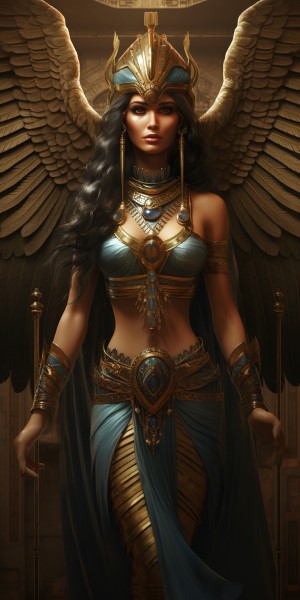 Isis:
Isis:Isis, the magical mother, wove spells of protection and love, nurturing the land and its people with her boundless compassion.
- Appearance: Goddess with the body of a woman, often shown with wings and wearing a throne-shaped or horned headdress with a solar disk between the horns. The throne headdress relates to her name, which means "throne," symbolizing her role as the mother of kings and a protector of the throne.
- Attributes: Isis is depicted as a devoted wife and mother, a healer, and a magical protector. She is often shown holding an ankh, the symbol of life, or using her wings to protect or enfold others in a gesture of protection.
- Symbolism: Her wings symbolize her role as a protective goddess, who could bring the dead to life with her magical spells. The throne and horns with a solar disk emphasize her sovereignty, divine motherhood, and her aspect as a solar deity, reflecting her integral role in royal and everyday life.
- Isis coloring pages
-
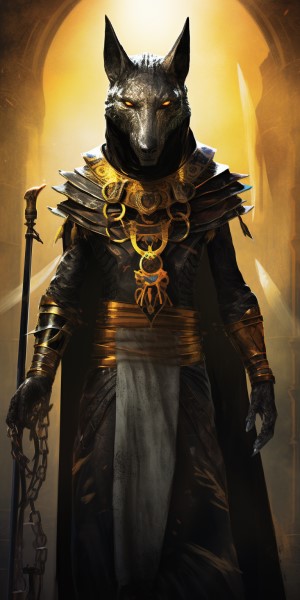 Anubis:
Anubis:Anubis, the jackal-headed guardian, stood watch over the mummification process, ensuring safe passage to the afterlife.
- Appearance: God with the body of a man and the head of a jackal.
- Attributes: Anubis is associated with mummification and the afterlife. Including a flail or an ankh (symbol of life) in one hand can highlight his role.
- Symbolism: The jackal head is distinct and recognizable, making Anubis one of the simpler gods to illustrate.
- Anubis coloring pages
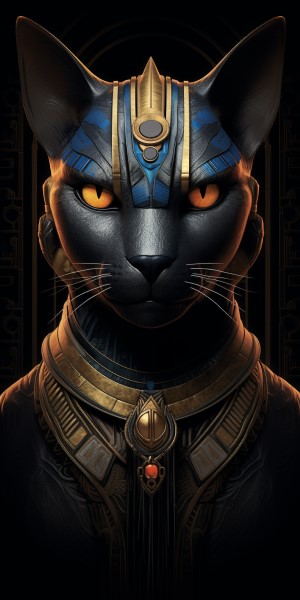
Bastet:
Bastet, the feline goddess, purred with grace, guarding homes with her watchful eye and bringing joy and music into the hearts of her people.
- Appearance: Goddess with the body of a woman and the head of a domestic cat.
- Attributes: Sometimes depicted holding a sistrum (a musical instrument) or an ankh. You might also include a cat or kittens at her feet to emphasize her association with cats and protection.
- Symbolism: The feline features convey her association with home, fertility, and protection.
- Bastet coloring pages
-
 Thoth:
Thoth:Thoth, the wise ibis, recorded the passage of time and knowledge, teaching humanity the power of words and wisdom.
- Appearance: God with the body of a man and the head of an ibis.
- Attributes: Often shown holding a writing palette and reed pen, symbolizing his connection to wisdom, writing, and knowledge.
- Symbolism: The ibis head is straightforward to draw and instantly identifies the deity as Thoth.
- Thoth coloring pages
-
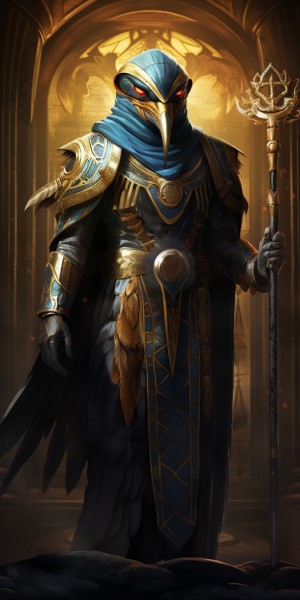 Horus:
Horus:Horus, the falcon in the sky, spread his wings to protect the pharaoh's power and bring victory and order.
- Appearance: God with the body of a man and the head of a falcon.
- Attributes: He is often depicted wearing the Pschent (the double crown of Egypt), representing his rule over all of Egypt. A scepter or ankh can also be included.
- Symbolism: The falcon head, with its distinct beak and shape, makes Horus easily recognizable.
- Horus coloring pages

Sobek:
Sobek, the mighty crocodile god, lurked in the Nile's murky waters, embodying the river's strength and fertility, safeguarding its creatures and ensuring the life-giving floods.
- Appearance: God with the body of a man and the head of a crocodile.
- Attributes: Sobek might be illustrated with a headdress featuring a sun disk and upright feathers or holding an ankh or scepter.
- Symbolism: The crocodile head makes Sobek one of the more unique and simpler gods to depict due to its distinctive features.
- Sobek coloring pages
-
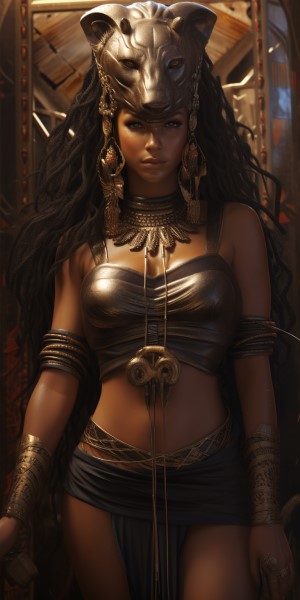 Sekhmet:
Sekhmet:Sekhmet, the lioness, roared with the power of the sun, fiercely protecting the balance of nature with her healing and wrath.
- Appearance: Goddess with the body of a woman and the head of a lioness.
- Attributes: Often depicted with a solar disk on her head and the Uraeus (a rearing cobra), symbolizing her connection to the sun and her role as a protector. She may also hold an ankh or a scepter.
- Symbolism: The lioness head conveys her fierce nature as a warrior goddess and healer.
- Sekhmet coloring pages
-
 Ra (or Re):
Ra (or Re):Ra, the sun god, sailed across the sky in his golden barque, bringing light and life to the world, his warmth touching every corner of the land, from the smallest grain of sand to the grandest pyramid.
- Appearance: God with the body of a man and the head of a falcon, similar to Horus, but distinguished by a sun disk encircled by a cobra (Uraeus) atop his head.
- Attributes: Ra is often shown holding a scepter and an ankh, symbols of power and life, respectively.
- Symbolism: The sun disk represents his role as the sun god, creator, and giver of life.
- Myth: The Journey of Ra
- Ra coloring pages

Hathor:
Hathor, the celestial cow, danced across the sky with mirrors reflecting the beauty of life, her songs filling the air with joy and her motherly embrace offering comfort and guidance.
- Appearance: Goddess with the body of a woman, often with cow ears or entirely as a cow. Sometimes depicted with a headpiece that includes cow horns with a sun disk nestled between them.
- Attributes: Hathor can be illustrated holding a sistrum or a mirror, signifying her association with music, dance, joy, and beauty.
- Symbolism: The cow imagery represents her aspects of motherhood, fertility, and nurturing.
- Hathor coloring pages
-
 Set (or Seth):
Set (or Seth):Set, the force of the storm, challenged the balance, reminding everyone of the strength found in adversity.
- Appearance: God with the body of a man and the head of a mysterious animal often referred to as the "Set animal," which resembles a composite of a canine, aardvark, and a donkey.
- Attributes: Set might be depicted holding the Was scepter, symbolizing power, or a thunderbolt, denoting his association with chaos and storms.
- Symbolism: The unique appearance of the Set animal makes him easily distinguishable and symbolizes his role as a deity of chaos, deserts, storms, and foreigners.
- Set coloring pages
-
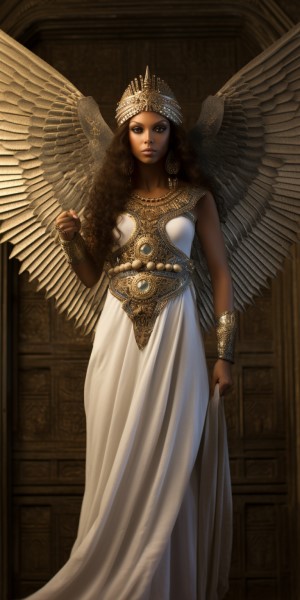 Nephthys:
Nephthys:Nephthys, the guardian of the dead, spread her protective wings in the shadows, whispering secrets of rebirth and standing by those journeying into the afterlife, ensuring their safe passage and peace.
- Appearance: Goddess with the body of a woman, often depicted with a headdress that includes a house and basket hieroglyphs, representing her name.
- Attributes: Nephthys can be shown with wings spread in a protective gesture, signifying her role as a protector of the dead and a symbol of mourning.
- Symbolism: The simplicity of her iconography, focused on protection and mourning, can be conveyed through her poised, serene posture and the symbolic headdress.